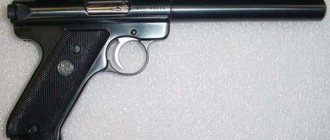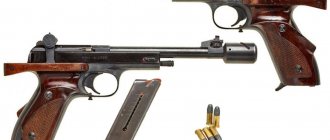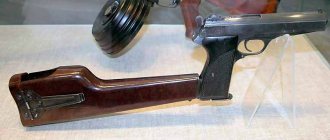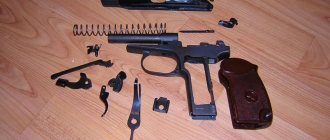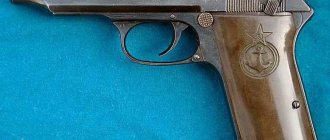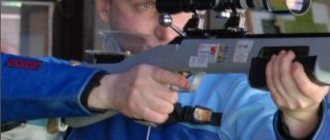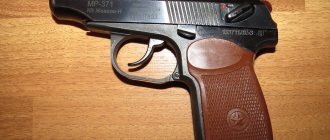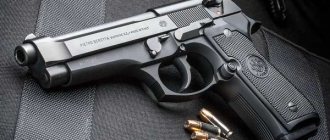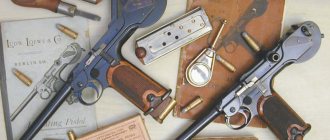History of creation
Margolin began creating a small-caliber training and sports pistol in 1938. Before this, he had already made several attempts to design weapons of this kind.
The results of his work were modifications of standard army TT pistols and the Nagan revolver, converted to fire small-caliber cartridges.
However, the development of the promising Margolin pistol was prevented by the Great Patriotic War. The designer participated in the defense of Moscow. Was awarded a medal. After the end of this terrible war, Margolin resumed his work.
As a result, the resulting pistol resembled the legendary TT in appearance and was made on its basis. The design turned out to be unreliable and had to be modified.
Margolin carried out a long and painstaking work, during which he took into account all the technical developments.
The result was a fundamentally new design, completely different from the previous model. Having passed test tests in 1947, the pistol was put into production in 1948 under the marking MTs-1. In 1952, a modification of the MCM was adopted to replace the MTs-1. The main difference was the cartridge used.
From 1950 to 1970, the Margolin pistol was used by athletes participating in all-Union and international competitions. The famous Soviet Olympic champions also used it. For example, Tatyana Ruchko, champion of the Ukrainian SSR.
Wooden suitcase for Margolin.
A statutory case for transporting and storing a Margolin pistol. Guaranteed original. Excellent collectible condition. It is extremely rare.
The Margolin pistol is a legendary Soviet sports pistol.
weapons of world and Olympic champions of the 50s–70s of the twentieth century. In terms of its parameters, it corresponds to a pistol of a standard class for competitions according to the rules of the International Rifle Union. In 1938, Margolin began to create a small-caliber training and sports pistol, but the war prevented the development. After its completion, work was continued and in 1946, after much trial and error, a small-caliber pistol was created that looked like a TT.
However, the design of the weapon turned out to be insufficiently debugged and Margolin had to seriously begin to refine it. To increase the accuracy of the battle, he took an unprecedented step, violating the basic rule of small arms design, which prohibits any welding in the chamber area, and welded the barrel to the pistol frame with two symmetrical electric welding seams.
This was considered unacceptable for military weapons, but in this case, deviations from generally accepted rules played a positive role.
The modified design performed well when testing prototypes, and the question arose about serial production of the model.
Nevertheless, Osoaviakhim, due to the “dampness” of the model, refused to produce it, referring to the already existing model of this class, created by designer Sevryugin - R-3 (copied from the TT combat pistol, however, also unfinished). For sport shooting, it was a sports pistol that was needed, and not a converted copy of a combat pistol. Such “alterations” worked unreliably and were characterized by poor combat accuracy, as a result of which they were extremely reluctant to be used in sports shooting organizations. Therefore, a huge number of P-3 and P-4 pistols were stored in warehouses, remaining unclaimed. Dissatisfaction with the quality of these models was justified. It was clear to everyone even slightly familiar with shooting sports that the sharp and strong blow of the trigger, the heavy trigger, the unreliable and limited adjustment of the sear spring and, finally, the shape of the handle, which corresponded rather to the purpose of a combat weapon, made these pistols completely unsuitable for shooting sports. .
That is why, at the beginning of 1947, Margolin, taking into account the most valuable technical achievements and design developments in the manufacture of his previous model, created a qualitatively new example of the original design. Already at the end of the year, a prototype was ready, which was put into mass production in 1948.
Thanks to the MC series pistols, many famous champions, masters of sports, and arresters were trained. Moreover, today these Soviet pistols are still the basis of initial fire training in sports shooting clubs in Ukraine.
And after the 90s, on the basis of the MC in Russia, several high-precision small-caliber combat pistols were created for special units of the armies of the world - “MARGO” (short barrel cal. 5.6 mm .22LR) and “DREL” (short barrel cal. 5, 45 mm PSM).
Design
The MCM pistol uses 5.6 mm small-caliber ammunition. The operating principle of its mechanics is based on the recoil of a free-sliding bolt. The trigger type trigger, with an open trigger, provides the ability to adjust the force on the trigger. Under the barrel there is a return spring with a guide stem.
Removable magazine in the handle, cartridges in a single row, capacity of 5,6 or 10 cartridges (caliber .22LR).
Inside the barrel there are 6 rifling grooves going down to the left. The trunk itself is cylindrical. At the end of the muzzle there is a boss on which the front sight is mounted; some models have a thread there for attaching a compensator.
The firing device of the Margolin pistol has the following parts:
- Spring;
- Trigger with axle and rod;
- Sear with spring;
- Trigger rod with spring;
- Trigger;
- Striker with spring.
The sighting device is micrometric. It is possible to adjust the rear sight and front sight horizontally. This ensures optimal zeroing under the shooter’s hand and, accordingly, accuracy. To reduce recoil, the pistol can be equipped with a compensator.
For better balancing, special weights can be attached from below. The cheeks and the shape of the handle are orthopedic, comfortable and ergonomic. The pistol was supplied with spare parts (Spare parts included). There were various loads for changing the balance of the pistol, weapon care products and spare magazines.
Performance characteristics
| All weapons without ammo | 0.9 kg |
| Weight with full clip | 0.94 kg |
| Weapon length | 24.5 centimeters |
| Barrel length | 15.2 centimeters |
| Caliber | 5.6 millimeters |
| Ammunition used | 22 LR |
| Initial bullet speed | 305 meters per second |
| Sighting range | 25 meters |
| Type of ammunition | Magazine for 10 (MTs-1), 5 and 6 (MTsM, MTsU) rounds |
| Sights | Open type, adjustable |
Modifications
The design of the Margolin pistol turned out to be very thoughtful and successful. The MCM is still used as a training weapon in the 21st century, but relatively few modifications based on it have been produced.
Most of the improved models were designed after 1990. Export options have appeared.
| Model name | Description |
| MC-1 | The very first model adopted into the series in 1948. |
| MCM | Modified modification of 1952, for “short” ammunition |
| MCU | Special development for accelerated shooting. |
| MCM-K “Margot” | Development by designer Yarygin, based on the MCM. It has a barrel shortened to 98 mm and uses the .22LR cartridge. The Margo pistol has been produced for export since 1992. |
| "Drill" | Variation “Margot”. The barrel length was shortened to 78 mm. The cartridge used is 5.45*18 mm. |
| “Super Drill” M2 | A special modification of the standard “Drill”. The fuse has become a push-button one. |
| MP-449 | Option chambered for .25 ACP |
| IZH-77 | Produced since 1993. Gas. There are two options: chambered for 8*20 mm and TK-024 |
Today, mass-dimensional models of the Margolin pistol are produced for collectors. Fully consistent with the original, with the exception of the ability to fire. The MMG can be disassembled like a real weapon; almost the entire diagram corresponds to the real design.
Review of the Margolin MC/MCM pistol
Photo: Margolin Pistol / MC / MTsM. Selection-1 Photo: Margolin Pistol / MC / MTsM. Selection-2
The Margolin pistol (MC) is a Soviet small-caliber self-loading pistol. The pistol is intended for training and sports shooting MP-5 at a distance of 25 meters. The pistol uses a 5.6mm (22LR) cartridge. The development of the pistol from 1946 to 1948 was carried out by Mikhail Vladimirovich Margolin. The first batch of five pistols was manufactured in 1947. The Margolin pistol can be found under the abbreviation MC , which stands for “Model TsKIB”, since the documentation and drawings for the production of the pistol were prepared at TsKIB SOO in Tula. According to another version, the abbreviation MC stands for Small-Caliber Target. MCM stands for “modernized” accordingly. The pistol was produced from 1948 to 1979 at the Izhevsk Mechanical Plant (IZHMASH). It is still produced in other modifications today.
Story
Please note that the gun was created by a designer who was completely blind. At the age of 18, during the establishment of Soviet power in Abkhazia, Mikhail Vladimirovich Margolin was wounded in the head, as a result of which he completely lost his sight. After which he took courses as massage therapists, but his love for weapons was so high that, being blind, he first became an instructor in the military office at the First Model Printing House (Moscow) in DOSAAF (OSOAVIAHIM - called at that time), where he was in charge of training models of rifles, grenade, Maxim machine gun, etc. In this office he met brigade commander A.A. Smirinsky, who told Margolin that the country needed sporting weapons, which became Margolin’s way of life. Margolin's blindness was compensated by excellent tactile memory of the fingers and visual imagination. At exhibitions, Margolin studied weapons by touch, created sketches of his ideas from wood and plasticine, and placed weapon mechanisms on plywood. In 1934, OSOAVKHIM suggested that Margolin modernize the TOZ-1 sporting rifle. After which he created the Degtyarev infantry machine gun for firing small-caliber cartridges. In 1948, Margolin became an employee of TsKIB-14, where he worked with Tokarev, who showed him foreign models and domestic developments of small arms. Here he created a rather original TKB-206 pistol chambered for a 9-mm cartridge; the pistol was not accepted for service because the People's Commissariat of Military Industry ordered the designers not to develop pistols for this caliber. Before the war, Margolin created several samples of sports pistols based on the TT pistol chambered for 7.62 and 9 mm calibers, but they did not arouse the interest of the military due to the insufficient accuracy of the pistols. Around the same time, Margolin proposed upgrading the TT pistol to a 9-mm cartridge; the pistol successfully passed tests, but the military did not appreciate Margolin’s work. After the war, Margolin returned to creating sporting pistols. He became interested in the opinions of shooters, turners, and other designers on what a sports pistol should be like. Margolin decided to rigidly attach the pistol barrel to the frame, which was rarely practiced at that time, and move the front sight from the bolt to the pistol frame. As a barrel, Margolin used a small-caliber 5.6 mm barrel from Walter with 6 grooves for its accuracy and low recoil. In the fall of 1947, Mikhail Vladimirovich presented 5 prototype pistols, which were tested by the coach of the Dynamo shooting club F.I. Zhamkov. In 1948, Margolin received an author’s certificate “Self-loading sports pistol of 5.6 mm caliber designed by Margolin.” In 1949, Kalichenko, a master of sports in bullet shooting, won the title of world champion a Margolin pistol This pistol became the main training and sports pistol in the USSR and other countries, even after 60 years it continues to bring gold to athletes in various competitions. The reliability of the Margolin pistol has never been criticized in the weapons world. This wonderful pistol was molded from plasticine by a completely blind man.
Design
The automatic operation of the Margolin pistol works due to the recoil of the free bolt. During a shot, powder gases press on the bottom of the cartridge case, which transfers recoil energy to the bolt, and it rolls back. Since the bullet speed is higher than the shutter speed, the bullet ejects until the cartridge case is extracted. During recoil, a special spring-loaded hook catches the cartridge case for its extraction to the right side. During the recoil of the bolt, the mainspring, which is located under the barrel, is compressed; after the shot, it completes the reloading cycle by pushing the bolt frame back into the firing-locking position with the supply of a new cartridge from the magazine. Also, during the shutter rollback, the firing mechanism is cocked. Since 1952, to make the pistol lighter, it was decided to replace the steel bolt with an aluminum bolt. To power the pistol, single-row box magazines with 5/6/10 rounds are used. For the convenience of loading the magazine, it has a protrusion with which you can compress the spring. Double-action trigger mechanism: pre-cocking the hammer or pressing the trigger harder. The safety of the pistol is ensured by a safety bracket on the left side of the pistol; the safety can act as a slide stop. Pistols produced from 1949 to 1955 did not have a safety lock. Additional safety of the pistol is provided by the trigger mechanism, which does not allow firing a shot when the bolt is not fully locked. The pistol does not have an automatic shutter release after the cartridges have been used up. The trigger has an adjustable release force from 0.5 to 1.0 kg and an adjustable stroke length from 1 to 5 mm. A micrometer sight is used for aiming. There is adjustment of the rear sight horizontally and the front sight vertically. The peculiarity of the pistol is that the rear sight is located on the protruding part of the frame, and not on the bolt, which significantly increases the accuracy and accuracy of shooting, since the front sight is not affected by the recoil of the bolt. The barrel has 6 grooves, the barrel is rigidly attached to the pistol frame, and there are rifling for installing a muzzle brake compensator. Until 1955, pistols were produced with barrel lengths of 180 mm and 140 mm. After modernization, it was decided to install barrels with a length of 152 mm. For ease of shooting, Margolin pistols can be equipped with orthopedic grips, DTK of various models, balancing weights, and “mushroom” handles.
Modifications of the Margolin pistol:
- MTs-1 - sample of the 1948 model
- MCM-modernized Margolin pistol
- MCU-pistol designed for high-speed shooting
- MCM-K “Margot” is a pistol with a shortened barrel up to 98 mm, the modernization of the pistol was carried out by V.A. Yarygin in 1990, serial production started in 1992.
, - IZH-77 (index GRAU-6P36) - a gas pistol is produced in two calibers: the TK-024 7.6 mm cartridge and the 8x20 mm cartridge. The pistol has been produced since 1993.
“Drill” - modification of MCM-K for firing 5.45x18 mm cartridges, barrel length 78 mm - MP-449 - export version chambered for 6.35x15.5 (.25ACP)
- EMA10 rifled carabiner.
Technical characteristics of the Margolin / MC / MTsM pistol
| Index | MC-1, MCM, MC |
| Number of shots | 5/6/10 in store |
| Barrel diameter | 0.22LR, 5.6x15.6 mm, 152 mm barrel length |
| Combat rate of fire | no data |
| Sighting range | 50 meters |
| Maximum firing range | no data |
| Initial departure speed | 275-510 m/s |
| Power | 90-130 Joules |
| Automation | blowback recoil |
| Weight | 0.9 kg without cartridges and 0.94 with cartridges |
| Dimensions | Length 126 mm, thickness 20 mm |
Combat use
After the collapse of the Soviet Union, many weapons enterprises in our country began to experience difficulties with financing and were forced to begin developing weapons aimed at the civilian market or export.
This situation did not escape the Izhevsk Machine-Building Plant, which produces the MCM sports pistol. Design engineer Yarygin developed a new product based on the Margolin pistol, which was planned to be sold to other countries.
The resulting pistol was called MCM-K “Margo”.
This model of personal small arms, due to its technical characteristics and the high stopping power of a soft-shell 5.6-mm bullet, began to be used not only as a sporting weapon, but also as a means of self-defense.
There were attempts to produce pistols based on the MCM for the Russian Ministry of Internal Affairs. The development was carried out under the “Drill” marking and had a shortened barrel. The pistol fit easily into an employee’s pocket without attracting unnecessary attention.
5.6 mm sports training pistol MCM-K “Margot”
ONE of the first in our country in 1990 was the appearance of a small-sized 5.6-mm sports training pistol MCM-K, created by designer V.A. Izhmekha. Yarygin. It was a remake of one of the most popular Soviet small-caliber pistols - a sports pistol designed by M.V. Margolin MCM, designed to use a 5.6 mm (.22 LR) rimfire cartridge.
Initially, the 5.6-mm MCM-K pistol was positioned by Izhevsk gunsmiths as a sports training weapon, which received the poetic name for export - “Margot”, intended for sports training shooting in sports shooting ranges and on shooting stands. However, due to its small weight and size characteristics (total length - 193 mm, height - 130 mm; thickness - 38 mm; weight without cartridges - 0.8 kg), the absence of protruding parts, good accuracy of fire and a fairly high stopping effect of the soft shellless bullets of a 5.6-mm target cartridge, it has received recognition abroad as a simple, reliable and inexpensive self-defense weapon. The operating principle of the automation is the use of the recoil energy of the free shutter. Inertial locking - by the mass of the bolt. The impact mechanism is trigger type, without self-cocking. The trigger mechanism included a comfortable trigger, pull rod and trigger sear. The protrusion of the rod served to separate it from the sear by a moving shutter casing. The return spring was placed under the barrel, and its rod was fixed with a pin. The safety device was made in the form of a special groove on the safety cocking of the hammer. When the trigger was placed in the “safety” position, the sear cocking rod entered the indicated groove, which ensured mutual locking of the trigger and sear. It was fed from a single-stack box magazine with a capacity of 7 rounds of .22 LR ammunition. When developing the MCM-K pistol V.A. Yarygin significantly shortened the pistol barrel (from 130 to 98 mm), made changes to the frame and replaced the adjustable sights with a non-adjustable rear sight. The trigger stroke increased from 1 - 4 mm (in the MCM) to 5 mm (in the MCM-K), and the trigger force - from 1.0 kg to 5 kg (respectively). From the Margolin MCM sports pistol, the Margot pistol received very good ergonomics. It was distinguished by a convenient and comfortable handle, good controllability of the weapon when shooting and aiming, as well as high combat qualities. In 1992, the Izhevsk Mechanical Plant mastered the production of small-caliber Margot pistols for export. Along with the development of foreign arms markets, Izhevsk gunsmiths made an attempt to “plow” undeveloped virgin soil in their homeland. A variant of the Margot pistol was proposed to arm operatives of the Ministry of Internal Affairs. At the same time, the “new” - old weapon, which received the factory designation “Drill”, was now designed to use another more powerful pistol cartridge 5.45x18 MPC, more suitable for performing the tasks facing law enforcement agencies. This model, shortened (relative to the Margot) with a total length of 173 mm, a barrel length of 78 mm and a weight of 0.56 kg, was equipped with a non-automatic safety lever, which also served as a shutter stop. It was mounted on the left side of the frame. For greater convenience of concealed carry, the outer contours of the bolt casing received smooth contours, and, unlike the Margot, the trigger was half-hidden by the casing. In addition, the Drill received a single-row box magazine with a capacity of 10 rounds. Soon another modification of it appeared - the 5.45-mm small-sized pistol "Super-drill" M 2, which was distinguished by the presence of a bolt stop: a push-button magazine latch mounted on the handle behind the trigger guard, and the presence of a finger rest on the trigger guard, ensuring ease of shooting with both hands, and the angle of the handle and its width and new shape ensured ease of aiming and shooting offhand. At the beginning of the 21st century, Izhevsk gunsmiths offered foreign business partners another version of the “Margot” - the MP-449 sports training pistol, designed to use the 6.35 mm Browning (.25 ACP) pistol cartridge, popular in the West. This model, unlike its ancestor, received a non-automatic fuse, which also served as a shutter stop. Along with this, Izhmekh also produced two versions of 6P36 gas pistols, created on the basis of the Margo pistol - 7.6 mm IZH-77-7.6 and 8 mm IZH-77-8.
Interesting Facts
Perhaps the most interesting fact is the story of the fate of the designer of the MCM pistol. Mikhail Margolin, while serving in the commandant's office of the city of Kyiv in the early 20s of the last century, received a serious gunshot wound to the head.
The bullet hit the brain, which led to complete loss of vision. He designed his pistol while completely blind. I thought through the details in my head. Modeled using plasticine and wood.
The first weapon was a small-caliber rifle. After its creation, Margolin was noticed by Degtyarev and invited to his design bureau. He began working at the Tula Design Bureau. Implemented several modifications of conventional military weapons into training ones.
The MCM became the most popular pistol of its category in the Warsaw Pact countries. For about 20 years, the best sports shooters of the USSR defended the honor of their homeland in competitions around the world. Now the MCM is used mainly as a training weapon; a replacement for it is not yet in sight.
